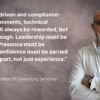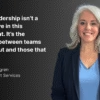The Future Of Leadership: The Agile Leader™
What is the future of leadership? We have spent the past year researching this topic and interviewing executives around the world.
We learned that the future is already here and that your organization’s survival is based on a number of key factors—including its ability to be agile.
The markets of today and tomorrow reward organizations that have the capacity and willingness to adapt. Market leaders have established cultures and management approaches that encourage creativity and rapid innovation. These approaches, commonly referred to as agile, encourage leaders to pivot faster in response to our volatile, uncertain, complex, and ambiguous world.
Many companies are attempting agile transformation, but without the shift in traditional leadership mindset, abilities, and development, they will be unsuccessful. It’s like putting a square peg into a round hole.
The business case for a new leadership model
We live in a fast-paced, ever-changing, disruptive time and it’s not slowing down.
Since 2000, 52% of Fortune 500 companies no longer exist.
Currently, 75% of all VC-funded startups don’t survive, 33% of small businesses fail, and only about 30% of family-owned businesses make it into the second generation.
If that isn’t concerning enough, the CEO turnover rate in 2018 was the highest we’ve seen in 10 years.
Here are more troubling stats:
- Twenty-one % of millennial workers say they’ve changed jobs within the past year.
- Only half of millennials anticipate they’ll still work at their company one year from now.
- Nearly half of non-millennials say they’re open to different job opportunities.
- Two out of three U.S. workers experience professional burnout.
- Eighty-five % of employees worldwide show some level of disengagement.
We are experiencing a time of rapid innovation and advances in technology and digitization. Consumers are constantly changing what they want and need, and their expectations have never been higher, demanding 24/7 personalized service.
We are living in the “now” generation.
What are the implications? Organizations, teams, and employees need to be nimbler than ever, which implies leaders need to be agile to create agile teams and organizations.
Are you an agile leader?
The five key drivers of agile leadership
The agile leader has the ability and capacity to assess risk, decide courageously, and act quickly to meet the rapidly changing environment while producing results and develop others’ capacity to do the same.
We have identified five key drivers of agile leadership and 10 leadership competencies that can be leveraged, at scale, to change how organizations work and get work done.
The five key drivers of agile leadership are:
- Integrity: Integrity is the foundation of agile leadership. Actions are driven by values and principles, which make leaders reliable and trustworthy. They have developed a depth of self-awareness, character, and purpose that naturally inspires those around them.Integrity is the most important leadership attribute, but it’s often overlooked or considered to be something that leaders simply have or don’t have. But we believe that any leader can develop integrity. The combination of self-awareness and accountability accelerates the development of leaders so their mindsets and behaviors are governed by principles of integrity.
- Innovation: Agile leaders have an innovative approach. They exhibit a natural curiosity about their environments, introducing and encouraging new ideas and creating a learning culture.The agile leader’s role is less command and control and more facilitative. Think of an agile leader as a curator or a gardener who invests in team growth. With an unrelenting commitment to serving customers, they are willing to challenge the status quo and drive change.
- Urgency: Agile leaders embody a sense of urgency. They bring focus to the organization by establishing challenging goals and maintaining a steady cadence. They make decisions quickly with imperfect data to keep the organization moving forward.Agile leaders decentralize decision making by abandoning hierarchy in favor of self-organizing, cross-functional teams. Companies who follow the discipline of talent optimization know that selecting an organizational structure that supports the business strategy—and then updating that structure as needed—is key to success.
- Engagement: Agile Leaders create engagement across the organization. They are inclusive across boundaries, generations, and geographies. They span up, out, across, and down complex networks of stakeholders to encourage cross-functional collaboration to generate optimal performance.Another key to talent optimization is the idea of developing leaders at every level. Agile leaders pull multiple levers to build engagement in individual contributors—and they understand that engagement begets productivity.
- Direction: Agile leaders create direction for the organization and align people and resources to fulfill it. They focus on removing impediments and empowering teams to self-organize and take charge of their work. They are transparent in their communication and encourage a free flow of information to rapidly adapt to change.Agile leaders create an agile culture based on shared organizational values that align your business and people strategies. You want a high-performing and engaged workforce? An organization that is aligned to your purpose, vision, and strategies? Be an agile leader.
Leaders, these questions can help you determine your agility.
These five key drivers of agile leadership and the 10 agile leader competencies are identifiable, observable, and measurable behaviors that are critical for a leader’s success.
As you read through these, ask yourself, am I an agile leader? Is my leadership team agile? What do I and my leadership team need to do to be more agile? What does my organization need to do to be more agile?
- Self-awareness: How aware are you of your natural leadership attributes and strengths? Organizations that use talent optimization know that self-awareness helps leaders at all levels establish emotional intelligence. How do you show up under pressure and stress? How would you rate your ability to work effectively with a variety of different people and situations?
- Accountability: Are you taking ownership of your and your teams’ responsibilities and results? Are all members of your team and organization holding themselves accountable?
- Challenging the status quo: Are you having courageous dialogue, asking the tough and unpopular questions? Are you curious and comfortable in challenging the norms and sacred cows?
- Decisiveness: Are you able to make decisions, even if you don’t have 100% of the data? Are you able to take risk and pivot in a new direction?
I recently read an interview with Jamie Head, CIO of Ocean Spray. Head said, “If we are not making mistakes, we are not pushing ourselves hard enough. So I want to see evidence of failures to learn from … and build that trust and innovation culture.”
About the Author: Chuck Mollor
Chuck Mollor is the founder and CEO of MCG Partners, a women-owned firm specializing in leadership and talent optimization. For 30 years, Mollor—a Harvard Business School executive coach and a former global CEO—has advised business leaders of startups, Fortune 500s, and not-for-profits across diverse industries
https://mcgpartners.com/the_agile_leader/
About MCG Partners
MCG Partners is a leadership and talent optimization firm– aligning your business and people strategy for maximum results. MCG Partners a woman-owned consultancy and is also a Predictive Index® (PI®) certified partner. To learn more please contact John Griffith at john.griffith@mcgpartners.com and at mcgpartners.com








